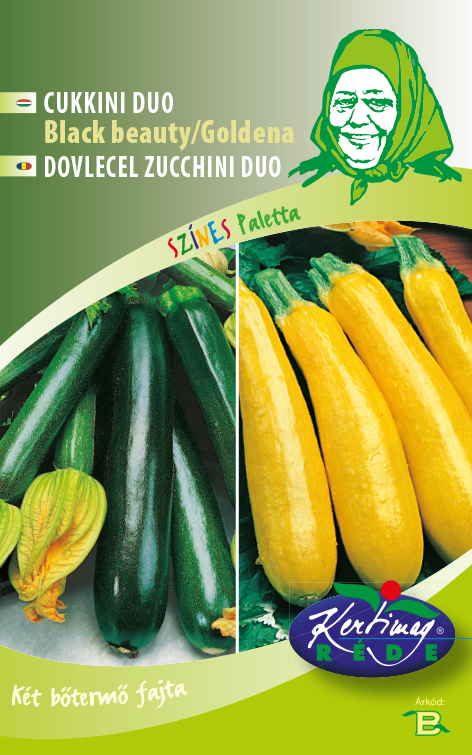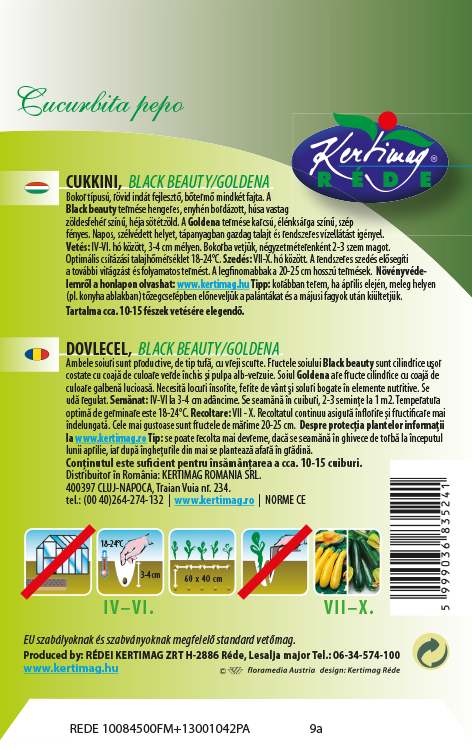Courgette pair (Black beauty and Goldena) 2x3 g
| HUF 369 * (nettó: HUF 291) | |
Courgette pair (Black beauty and Goldena) 2x3g
General description of Goldena courgettes:
Goldena zucchini is a medium-aged, very productive variety with golden yellow, elongated fruits that are very delicate. It can be eaten raw or as a salad.It is a compact growing variety with a high yield. The cylindrical fruit is bright yellow in colour and has a nice shine. The skin is dark orange when fully ripe. The fruit is best when 10-20 cm in size.
General description of courgettes Black Beauty:
A bush-type zucchini variety. The fruit is regular cylindrical, slightly ribbed, with dark green skin and white flesh. Depending on the size of the harvested crop, it is a versatile squash.
About courgettes
Zucchini has a highly developed radicle that penetrates deep and branches off into numerous lateral roots. The root system can reach up to 1.5 m in depth and width, so that a single plant can cover 2-3m3 of soil. There is a correlation between root development and length and soil water supply: the root system is larger in dry conditions.
The length of the creeping stem varies from one species to another, but is usually short (40-80 cm). On its five-veined, grooved stem, the epidermal cells divide to form multicellular hairs, which end in a single pointed apical cell. In addition, there are also glandular hairs composed of several cells forming a head. The stalk is furnished with bicol-lateral (middle tail, outside-inside lobe) conveyor beams typical of gourds. These tendrils are arranged in two circles, mainly near the tip. The leaves are densely arranged on the stem, with medium to deep lobes and deep lobes. The petioles are usually longer than the leaf plate and the leaf lobes are pointed. The veins on the petioles and bracts are spiny to the touch from the stiff hairs.
Flowers are unisexual and bisexual. The green sepals are 5 in number, the lower half of the sepals are connate, the sepals are pointed-tipped. The petals, also 5, are similarly connate, the pads are funnel- or bell-shaped, 10-15 cm wide. Stamens free, possibly with 2 to 2 petioles, the claspers may be fused with their backs. Lower seed coat formed by 3 bracts. Fruit elongated-cylindrical, some fruits at young age with the stalk of the catkin fruits wine-dazed. Skin dark green with white spots or stripes, flesh white. The flattened egg-shaped seed is slightly pointed, pale yellowish-white. The seeds consist almost entirely of petiole.
Needs light:
Space requirements:
Water requirements:
Zucchini is quite water demanding in the early stages of its development, but regular watering should be kept up to ensure a good crop. It also requires regular hoeing and weeding.
Growing courgettes:
Planting seedlings:
When planting, it is a good idea to make nests for the seedlings 1 metre apart and amend the soil by tilling before planting. Another thing to remember is to place the courgettes in different places in the garden each year.
Indoor seedlings can be started at the end of March or beginning of April. Sow the seeds in well-textured soil-filled cups, about 2-3 cm deep. Keep the cups in a warm, sunny place and water regularly. The seedlings can be planted out after the danger of frost has passed.
Growing by sowing in situ:
Although it can be grown by sowing, the growing period is shortened and the fruits ripen later, so it is better to plant pre-grown seedlings. If sowing in the open ground is preferred, sowing can be done from late April to mid-July.
Plant protection:
Proper plant protection should not be forgotten. Although courgettes have few typical diseases and pests, they can be attacked by powdery mildew and slugs.
Use
It can be prepared in a wide variety of ways, just like patissons. It is easy to digest and low in calories, so it is highly recommended in diets, for example for diabetics.
| Weight: | 0.006 kg |
|---|---|
| Width: | 140 mm |
| Height: | 80 mm |
| Length: | 1 mm |
| Aviability: | 1-4 nap |
| Basic sales unit: | db |
Login
Login

